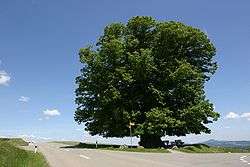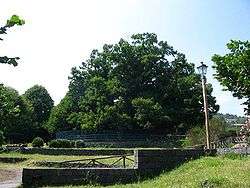Veteran tree

A veteran tree or legacy tree is a tree which, because of its great age, size or condition, is of exceptional cultural, landscape or nature conservation value.
Definition
Veteran trees vary in age depending upon their species and location, but may be several hundred years old. Smaller and shorter-lived tree species (such as orchard trees) may begin to develop some veteran features when only a few decades old. Size is usually used to define veteran trees. This may be size alone: for example, a girth of over 3 metres (9 ft 10 in) at 1.5 metres (5 ft) may be used as a test; alternatively, different girths may be set for species of different sizes, and the presence of veteran tree features may also be considered.[1]
Veteran trees often have features of particularly high nature conservation value, such as dead limbs, hollows, rot-holes, water pools, seepages, woodpecker holes, splits, loose bark, limbs reaching the ground, and epiphytic plants and lichens.[1] Few of these features are found on younger trees, and they provide habitats for very many species of animals and fungi, some of which are rare. Such features are sometimes removed or damaged by pruning or other arboricultural practices.
Many of the oldest trees are pollards, as pollarding removes the weight and windage of the upper trunk and so reduces the chances of major damage, and it also maintains the tree in a vigorous state.
Veteran trees occur in many situations, occasionally in dense woodland, but more commonly as hedgerow trees, on village greens, and in ancient parks and other wood pasture.
United Kingdom
Veteran trees are more frequent in Great Britain than in many other parts of Europe.[2] In the United Kingdom in recent years, these trees are being recorded by the Ancient Tree Hunt so that a national database can be created. Volunteer groups such as the Wokingham District Veteran Tree Association, the Dorset Greenwood Tree Project and the Ashford Veteran Tree Initiative are crucial to the success of this scheme.
Although some initiatives have strict rules on how to measure girth and use GPS devices to document the location of such trees accurately, other schemes rely on members of the public to report large trees. The public have been encouraged to hug big trees in their area to get a measure for their size and report their findings to Natural England or another Veteran Tree organization. 19th-century maps are also being used to find old trees in places such as Cambridgeshire.[3]
Australia
In Australia some of the oldest veteran trees are intimately connected with social, cultural and legal practices of the Aboriginal peoples.
However even the more recent European history of settlement has produced historical linkages through resilient individual trees that have survived when all other traces of past events have long since disappeared. Along with the very obvious and well documented wholesale clearance of vegetation, European settlers also demonstrated an understanding of the importance of trees in their immediate surroundings.
Existing prominent trees were very often used as markers, survey points indicating boundaries of both private and government land tenure. Some of Australia’s most famous trees hold an exalted position in our shared psyche simply because they were marked (blazed) by 19th-century explorers.
Australia does not have the history of the commons and parklands that help explain these landscape forms elsewhere. The new settlers did however bring with them an appreciation of the value of trees for fuel, fodder and raw material for building; many of them also showed an appreciation of the amenity value of trees, planting large spreading shade trees on their properties and within their new founded towns and cities.
Many of the veteran trees identified today are living reminders of the previous patterns of settlement, reflecting the economic, cultural and social organization influencing the lives of those living on the land. They often display the physical scars of traumatic events both man made and natural, those scars can often make relatively young trees appear much older than they actually are - such trees can be described as having been veteranised.
Unfortunately whilst there is legislation (in the form of national, state and local laws) which recognises the importance of protecting the environment there are many gaps in the limited protection afforded veteran trees, particularly in the face of ever increasing pressures of urban development.
The Veteran Tree Group Australia, a volunteer organisation, is applying the successful model from the Ancient Tree Forum in the UK starting the process of documenting veteran trees in Australia, and along the way providing best practice advice to anyone wanting to understand more about these significant elements of our environment.
Italy

In Italy general features required in order to identify an Albero Monumentale (literally monumental tree) are defined by a the national law nr.10 of 14 January 2013 Norme per lo sviluppo degli spazi verdi urbani,[4] which also compels the Italian municipalities (comuni) to take a census of their veteran trees. Defining local standards, datails of censuses and law enforcements aspects as fines or subsidies related to vetean trees is a matter transerred to regions, which usually implement specific leggi regionali (regional laws).[5]
Silvicuture and veterans
Silviculture originally was developed to provide timber from forests run as plantations. But now forestry expands to consider non-economic values and ecological values. As a result these other values are also considered in silvicultural systems that may lead to veteran trees being supported where they exist or created where they have not previously been so considered. The Shelterwood with reserves method is a form of Shelterwood cutting that may do this.[6]
See also
References
- 1 2 Higher Level Stewardship: Part B, Farm Environment Plan Features Manual, Second Edition, pp 121–124. Natural England, October 2008, ISBN 978-1-84754-079-9
- ↑ Meetings with Remarkable Trees. 1996. ISBN 0-297-83255-7. (made into a radio and television series of the same name)
- ↑ BBC NEWS | England | Cambridgeshire | Maps boosting ancient tree search
- ↑ GU Serie Generale n.27 del 1-2-2013, www.gazzettaufficiale.it
- ↑ Alberi Monumentali, Regione Liguria, www.agriligurianet.it
- ↑ Silviculture Concepts and Applications, Ralph D. Nyland 2002 pg. Ch 14 Shelterwood and seed-tree methods
External links
- The Veteran Tree Group Australia blog
- Ancient Tree Forum
- The Future for Veteran Trees. English Nature, 2000. ISBN 1-85716-509-8
- English Heritage: Veteran Trees information — English Heritage
- Veteran Trees Management Handbook, English Nature, 2000. ISBN 1-85716-474-1
- Monumental Trees gives, oldest, tallest and biggest trees across the world.